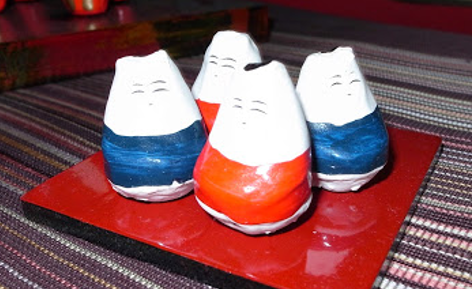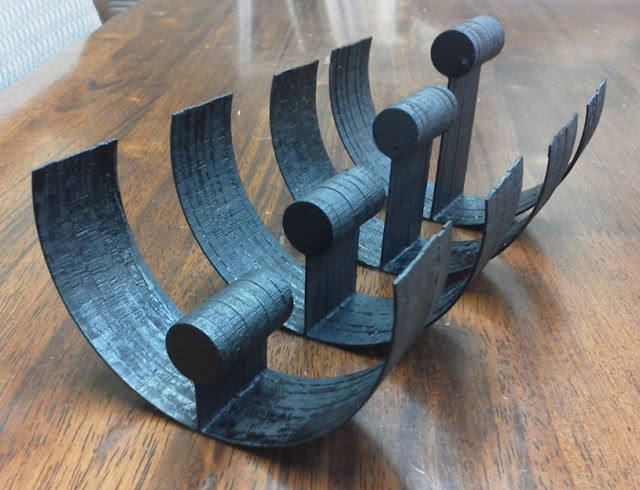起き上り小法師からオキアガリコボシへ From a Daruma Doll Righting by Itself to Another okigari-koboshi
会津の郷土玩具の一つである起き上がり小法師に注目する。大小あるものの基本的は同じ形に同じ顔である。しかしながら,一たび動き始めると,それぞれに異なる。個性があるのだ。気ぜわしく起き上ってくるもの。反対に,倒されたままなかなか起きてこないもの,様々である。どうやら現地では選挙の当確占いにも使っていたそうだ。それだけ,多様な個性にあふれている。
This section looks at one of Aizu's local toys, okigari-koboshi. Although large and small, they basically have the same shape and the same face. However, once they start to move, each one is different. They seem to have their own personality. Some rise up with a great deal of energy. On the other hand, there are those that remain knocked down and do not get up easily. Apparently, they were also used locally to predict the winner of elections. That is why they are full of diverse personalities.
The okiagari-koboshi
1. 起き上り方の違いの訳 Explanation of the Different Behaviour of the Dolls in Righting Themselves
その個性つまり倒されたときに戻ろうとする動きの多様性はどこから来ているのであろうか?どう考えるべきなのか。ぜひ入手して,もしくは似たような形を作ってみて試してみてもらいたいものだが,いろいろ模索していると以下のようにまとめることができるかもしれない。
Where does this individuality, i.e., the diversity of movements to get back up when knocked down, come from? What should we think about it? I would like to encourage you to try to obtain or make a similar form and test it out, but in exploring the various possibilities, we may be able to summarise it as follows.
- それぞれの重心とおしりの接地ポイントの位置関係の違い
- おしりの形
1. Differences in the positional relationship between the ground contact point of the base of each doll and the centre of gravity of each doll
2. Shape of the base of each doll
1については,「起き上がり小法師がなぜ起き上るのか」から始めなければならないが,実物のままでは情報量が多すぎる。したがって,オキアガリコボシへのモデル化を図った。
For point 1, we have to start with the question: 'Why does the koboshi get up by himself?’ but the amount of information needed to elucidate the ‘righting-up’ mechanism in its entirety is too great. Therefore, modelling a simplified okiagari-koboshi, in which some details were omitted and deformed to make matters less complicated, was attempted.
2については,1も含めて,手作りゆえの一個一個の微妙な違いが,見た目以上に敏感にその挙動に影響を与えていると理解したほうが健全であるように思われる。
As for point 2, given point 1, it seems more reasonable to understand that the subtle differences in each individual handmade item will affect its behaviour more sensitively than might appear at first sight.
2のおしりの形までモデル化し,パラメトリック(形を構成する基本特徴のいくつかを変数(パラメータ)として,その変数を操作することで形を制御する)にその形の多様性を再現することは可能であるが,ここで最も大切なことは,「なぜ起き上るのか」と「なぜ違う速さで起き上るのか」の2点のみに注目することとする。
Although it is possible to reproduce the diversity of shapes of the bases of various dolls parametrically (i.e. by manipulating some of the basic features of the shape as variables, or parameters, and controlling the shape by manipulating these variables), the most important thing here is to focus only on two points: namely, why the dolls rise up and why different dolls rise up at different speeds.
2. オキアガリコボシの制作 Production of the simplified okiagari-koboshi
起き上がり小法師のおしりの形の影響を抑えるために,モデル化においては半円とした。小法師それぞれの違いを重心位置の違いのみで表現することを考えた。この重心は,誰しも耳にしたことがあるし,誰もその存在を疑うことはないだろう。しかし,そのものを見たことがあるだろうか。それは物理現象をうまく説明する概念である。しいて説明しようとすると,ここでは,接地ポイントから観測したときに,小法師を構成する各部位の素材が持つ小質量の運動が小法師全体の運動に与える影響力を,ある一点に集中させた全質量による影響力に置き換えることができるときに,その点を重心と定義することができる。とにかく,小法師が十分に硬く変形することなくスウィングするときは,その具体的な形にとらわれる必要はない。重心の動きだけを見ていればいい。
In order to circumnavigate the complicating factor of the shape of the real base of the rising koboshi, a semi-circle was applied in the modelling of the simplified okiagari-koboshi. Thanks to this productive simplification, the difference between each koboshi could be represented by the position of its centre of gravity alone.
Everyone has heard of this centre of gravity, and no one would doubt its existence. But have you ever seen it? It is just a concept that successfully explains the physical phenomena of rigid bodies.
To try to explain the centre of gravity further, we can here define the centre of gravity as the point where the dynamical influences of the small masses composing the koboshi in the swinging motion are concentrated or represented.
At any rate, when the koboshi swings without being deformed in any way, it is not necessary to get bogged down by its specific shape. We only need to look at the movement of the centre of gravity in order to observe the essential movement of the koboshi and reproduce it with the simplified shape.
このような考え方において起き上がり小法師をモデル化したオキアガリコボシを提案した。
Following this line of thinking, the simplified okiagari-koboshi figures were proposed (see Fig.1), modelled on the traditional okiagari-koboshi dolls produced in Aizu.
図1 重心位置が異なるオキアガリコボシ the simplified okiagari-koboshi with different centres of gravity
図1の4体のオキアガリコボシの違いは重心位置のみである,と言いたいところだが,首部分の質量配分にはどうしても違いが生まれる。それでも半円のおしり部と首部の影響をできるだけ少なくすることを目的として,強度ぎりぎりで制作してある。材料は厚さ3㎜MDFである。図1から読み取れるように,1体はそれぞれ8枚の同型の積層で作られている。一層ごとの裁断ではレーザー加工機を使用した。
It would be tempting to say that the only difference between the four simplified okiagari-koboshi is the position of the centre of gravity, but differences inevitably arise in the distribution of the mass of the thin neck part. Even so, these parts, excluding the heads, would be made as thin as possible, keeping their strength low enough to minimise their influence on the mass of the semi-circular base. The material composing the simplified okiagari-koboshi is 3 mm thick MDF. As can be seen from Fig. 1, each body consists of eight identical layers. Each layer was cut from the MDF using a laser cutting machine.
図2 壊れたオキアガリコボシ the broken simplified okiagari-koboshi
壊れない程度に揺らしてみると,首が短いほどせっかちで,おしりの接地部を左右に滑らせながらスウィングするのに対し,首が長くなるにつれて,その動きは穏やかになる。それぞれの重量はほとんど変わらず,比較的わずかな首の長さの違い,つまり重心位置の違いによって,その動きが大きく異なってくることが観察される。
When gently shaken, the short-necked okiagari-koboshi swung impatiently, its base sliding from side to side on the surface of the table, whereas the movement became gentler and the swing more stable as the neck lengthened.
3. オキアガリコボシのシミュレーション
図3 オキアガリコボシのシミュレーション Simulation of the simplified okiagaki-koboshi
物理シミュレーターの一つであるWorking Model 2により,オキアガリコボシの揺動シミュレーションを実施した。図3は静止時のつり合い位置から左側にスウィングしようとしている瞬間を表している。反時計回りに減速しながら揺れている瞬間である。
A simulation of the swinging motion of the okiagari-koboshi was carried out with a physics simulator called Working ModelⅡ. Fig. 3 shows the moment when it has just swung to the left from the stationary equilibrium position. This is the moment of swinging while decelerating anti-clockwise.
重心近く,頭部の下口元あたりから鉛直方向に伸びている赤の矢印は,このモデルにおける重心からの自重つまり物体力を示し,その左側の臀部の接地ポイントからの鉛直方向上向きの赤色矢印は床面からの反力(ベクトル)を示している。頭部で円の中心が重心となっていない理由は,首部と臀部にも小質量が分布しているためのずれである。今回は,この程度のあいまいさは許していただきたいと考えている。
The red arrow extending downwards vertically from near the centre of gravity, around the mouth, indicates the body weight, or the body force, from the centre of gravity in this model; the other red arrow pointing vertically upwards from the ground point of the base on its left side indicates the reaction force (vector) from the floor surface. The reason why the centre of gravity is not at the centre of the circle in the head is that small masses are also distributed in the neck and base. I hope a degree of ambiguity may be forgiven in this explanation.
さて,もともとの命題である起き上がり小法師が起き上る訳であるが,図3からその理由を読み取ることができる。再掲となるが,図3に表された瞬間はオキアガリコボシが左に振れ,さらに左に倒れこもうとしている瞬間である。この時,物体力を表すベクトルの始点を中心に,そこで観察できるモーメントを算出すると,この瞬間にオキアガリコボシにかかるモーメントは臀部左側にかかる反力による時計回りのモーメントであることがわかる。オキアガリコボシそのものは反時計回りに回転している最中に,時計回りにモーメントが発生する,つまり回転運動を抑える方向にモーメントが生じていることが理解できる。これが,オキアガリコボシが起き上がりであることのゆえんである。
Now, as for the original proposition - the reason why the okiagari-koboshi rises – this can be understood from Fig. 3. This shows the moment when the okiagari-koboshi has swung to the left and will swing further to the left. Supposing we calculate the moment that can be observed at this time on* the starting point of the vector representing the body force, or centre of gravity, we can see a clockwise moment that seems to try to move the okiagari-koboshi back clockwise halfway through the anti-clockwise rotation. This is the reason why the okiagari-koboshi rights itself.
物理を習い,慣性力なるものに聞き覚えがある人は,『この運動における慣性力の効果はどうなっているのか』とも気になるかと思う。幸いなことに,この単純化されたモデルにおいては,その慣性力も重心に集約できるとして,慣性力を示す力のベクトルの始点も,ここでのモーメントの中心つまり重心に一致すると仮定することができる。これにより,ここでは,重心に集中される慣性力が,上記モーメントの動的なつり合い関係に与える影響は少ないものとみなしてもいいかもしれない。
If you have studied physics and are familiar with inertial force, you may be wondering: 'What are the effects of the inertial forces in this motion?’ Fortunately, in this simplified model, the inertial forces can also be concentrated at the centre of gravity, and it can be assumed that the starting point of the force vector representing the inertial forces also coincides with the centre of moment here, i.e. the centre of gravity. This allows the inertial forces concentrated at the centre of gravity to be regarded as not contributing to the above moments that induce the possibility of clockwise rotation.
このモーメントの強さを決めるのは,この反力ベクトルの重心からの距離である。モーメントは力×距離で定義されるので,ここでは,反力ベクトル×重心からの距離で定義されることが確認できる。
首の長さを変化させてオキアガリコボシの挙動変化を観ようとするとき,その挙動を支配するモーメントの変化は,首部の質量が頭部と比較して十分に小さいと見なせるならば,首の長さによって変化する重心との距離に集約される。首が長くなれば長くなるほど,この距離が短くなることは容易に理解できるであろう。
距離が短いということは,この運動の復元力的な働きをなすモーメントが小さくなることを意味している。したがって,首の長い長男のオキアガリコボシはもっともおっとりとした動きを示すことになる。そして,最も首が短い末っ子は,この距離が長く,強い(復元)モーメントを得ることになり,フットワーク良く動く異なる。ステレオタイプだろうか。
It is the distance between the reaction force vector at the touch point of the base and the body force vector from the centre of gravity that determines the strength of the moment that tends to make the okiagari-koboshi return back to the upright position. Since the moment is defined by multiplying force by the distance, the moment on the centre of gravity is defined by multiplying the reaction force vector by the distance from the centre .
When trying to observe the changes in the behaviour of the okiagari-koboshi when varying the neck length, the change in the moment governing its behaviour is concentrated in the distance to the centre of gravity, which varies with the neck length, if the mass of the neck is seen to be sufficiently small compared to that of the head. It is easy to see that the longer the neck, the shorter this distance becomes.
The shorter distance means that the moment that acts as a restorative force for this movement is smaller. Therefore, the long-necked eldest male, the okiagari-koboshi, shows the most relaxed movements. And the youngest son, with the shortest neck, will have a stronger (restorative) moment due to the longer distance, and will move quickly with better footwork. Is this a stereotype?
4. オキアガリコボシから力学教材へ from the okiagari-koboshi to a dynamics material OKIAGARIKOBOSHI
図4 力学教材「オキアガリコボシ」のモックアップと先進入試への実装品 Mock-ups of the OKIAGARIKOBOSHI and its implementation
オキアガリコボシを発展させ,力学教材としての機能を持たせた。スタイロフォームや光造形機によるモックアップの制作と実験を通して,上図右図の力学教材を制作した。
A trial was envisaged in which the okiagari-koboshi would be developed to function as a dynamics material. Through the swing experiments and the production of a mock-up using styrofoam and a rapid prototyping machine (Fig.3, left), a dynamics material OKIAGARIKOBOSHI was produced (Fig.3, right).
同質量の単3乾電池4個を自由に配置することで,全体の重心位置を制御できるようにしたものである。さらには,それぞれの乾電池の配置よっての回転運動時に生じる慣性力の影響により,その動きの特性を繊細に制御することができる。もし,間違って,乾電池それぞれを同心円状に配置した瞬間,この「オキアガリコボシ」はスウィングすることを止め,同一方向に回転し続けることになる。つまり,重心位置とこの円盤の図心が一致してしまうので,ここで説明した復元モーメントなるものは発生しなくなり,起き上がりであることを止めてしまうのである。
In the educational device, by freely arranging four AA batteries of the same mass, the position of the centre of gravity of the whole of the device can be controlled. Furthermore, the inertial force generated by the rotational motion of each battery arranged in the disc controls the characteristics of its motion delicately. If by mistake, each of the batteries is placed in a concentric circle, the OKIAGARIKOBOSHI will stop swinging and continue to rotate in a direction. In other words, the position of the centre of gravity and the centre of this disc coincide, so that the restoring moment described above ceases to occur and the OKIAGARIKOBOSHI no longer sways.
図5 力学教材「オキアガリコボシ」のシミュレーション The simulation of the 2D-OKIAGARIKOBOPSHI swaying




.PNG)




コメント
コメントを投稿